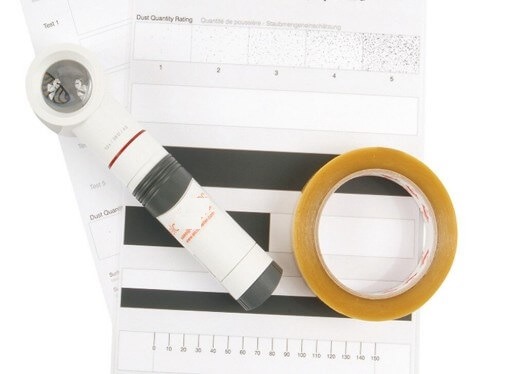Dust on steel surfaces can weaken paint adhesion and cause corrosion, especially on flat surfaces, pipe interiors, or structural cavities. The ISO 8502-3:2017 standard provides a simple method to check dust levels using adhesive tape. This article explains how to perform the dust test in an easy-to-follow way.
What Is the Dust Test?
This test checks the amount and size of dust on cleaned steel surfaces before painting. It uses sticky tape to pick up dust, which is then compared to standard images. It works best for steel surfaces with rust grades A, B, or C (per ISO 8501-1) and can be a pass/fail check or a record of dust levels.
Tools You Need
- Adhesive Tape: 25 mm wide, clear, sticky tape with strong adhesion (190 N/m per IEC 60454-2).
- Display Board: White or black board (e.g., paper, tile, or glass) to see dust clearly.
- Hand Lens: ×10 magnification to check dust particle size.
How to Check Salt Contamination on Steel Surfaces Before Painting
Steps to Perform the Dust Test
Follow these steps to test for dust:
- Prepare the Tape:
- Peel off and discard the first three turns of tape.
- Cut a piece about 200 mm long.
- Stick the Tape on the Steel:
- Hold the tape by the ends to keep the sticky side clean.
- Press 150 mm of tape firmly onto the steel surface (suitable for rust grades A, B, or C).
- Press the Tape Down:
- Thumb Method (most common):
- Press your thumb on one end of the tape.
- Slide your thumb back and forth three times each way, taking 5–6 seconds per slide.
- Remove the tape carefully.
- Thumb Method (most common):
- Place Tape on Display Board:
- Stick the tape onto a white or black board.
- Rub gently with your thumb to secure it.
- Check Dust Amount:
- Compare the tape to pictures in ISO 8502-3:2017 Figure 1 (ratings 1 to 5, where 1 is least dust).
- Pick the closest match and note the rating.
- If the tape looks discolored (e.g., reddish-brown), mark it as rating 5, size class 1.
- Check Dust Particle Size:
- Use the ×10 lens to look at dust particles.
- Match the size to ISO 8502-3:2017 Table 1 (size classes 0 to 5, smallest to largest).
- Note the size class. Discoloration counts as size class 1 (tiny particles, <50 μm).
Test Options
- Pass/Fail: Check if dust levels meet your project’s standards.
- Record Keeping: Save the tape on the board to show dust levels for quality checks.
Tips for Success
- Surface Type: Don’t use on rust grade D surfaces (deep pits prevent good tape contact).
- Consistency: Experienced testers get better results. Use standard samples for comparison.
- Discoloration: Fine dust causing discoloration can harm paint adhesion, so note it carefully.
- Test Planning: Agree on test locations, timing, and frequency with your team.
Why It Matters
Dust can ruin paint jobs by weakening adhesion or causing rust. This test ensures steel surfaces are clean, helping coatings last longer and perform better.
References
- ISO 4618: Paints and Varnishes — Terms and Definitions.
- ISO 8501-1: Visual Assessment of Surface Cleanliness.
- IEC 60454-2: Pressure-Sensitive Adhesive Tapes — Test Methods.

